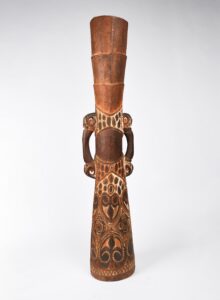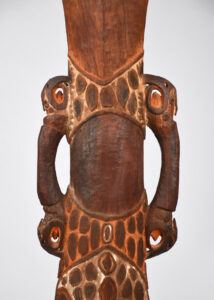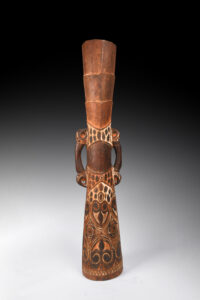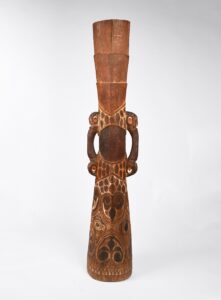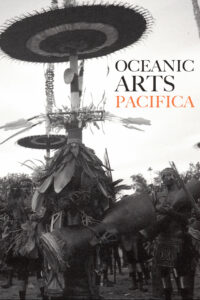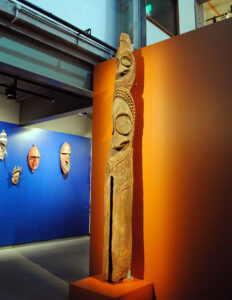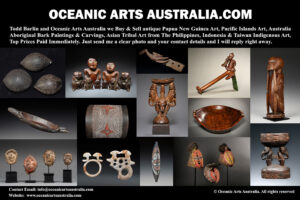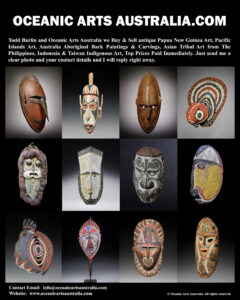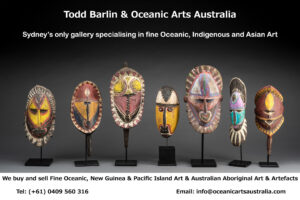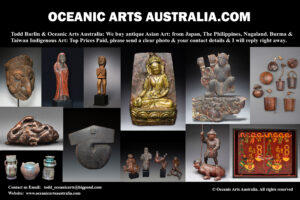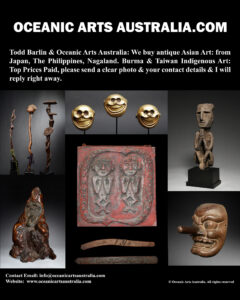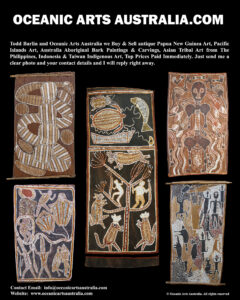A Superb Old New Guinea Water Drum Sawos People Middle Sepik River area East Sepik Papua New Guinea
| Collection No. | T-5475 |
|---|---|
| Size | Height 152cm |
A Superb Old New Guinea Water Drum Sawos People Middle Sepik River area East Sepik Province of Papua New Guinea
This rare old Sepik River musical instrument is a Water Drum and is called abuk in the local Sawos & Iatmul languages. Water Drums are important ceremonial musical instruments that were used in pairs along with pairs of Sacred Flutes that were used in an enclosure where women & the non-initiated couldn’t see them, a hole was dug in the ground and filled with water, the Drum is handled by two men each holding one side of the handle the drum is pushed into the water and then quickly pulled out creating an eerie whooshing sound caused by suction. This is said to be the voice of powerful ancestral spirits.
The Water Drum is carved from a single piece of heavy hardwood & beautifully carved with two sets of totemic bird’s heads on both handles, the lower part with finely incised clan designs that include stylized faces and traces of ochre painting. The three ridges at the top of the drum where there are no designs, that is where the Drum gets submerged in the pool of water & hence the discoloration from the water & mud and it makes sense to leave that undecorated except as those ridges might be necessary to make the unique acoustical sound.
The Sawos people, who live along the middle reaches of the Sepik River, are among the most prolific and accomplished sculptors in New Guinea. Sawos’ religion was complex and included a diversity of rites and ceremonies devoted to ancestors, spirits, and other supernatural beings. Almost every important occasion had ceremonial aspects, and some, such as male initiations, lasted for months. Sawos ceremonies often included both secret rites known only to men and public performances in which women and children participated. In the past, warfare and headhunting were integral elements of religious life.
There seems there were three types of Water Drums: A shallow oval Dish Form with lugs which was the more common, An hourglass-shaped Water Drum with handles only at the top
and this type is the tallest and the rarest & most interesting in my opinion with the handles in the middle of the drum
Of my type of Water Drum, there are only three known examples I could find: the one in the PNG National Museum collected by Dadi Wirtz, the two in a photograph by Laumann which no one knows where or if they still survive.
Provenance: Old Collection Australia and The Todd Barlin Collection of New Guinea Oceanic Art
See my new EXHIBITIONS GALLERY showing the Museums and Art Galleries Exhibitions that I provided artworks for over the past 40 years. There is the link to the article about my artworks published in the prestigious Louvre Magazine in 1996
I have artwork for Museums and art Galleries but also for collectors at every stage of their collecting. I want to encourage people to explore the fine art of New Guinea & West Papua and the Pacific Islands and to be able to see and touch the artworks in a relaxed and friendly manner in my Sydney Gallery. I would like to invite you to visit my gallery and see the artworks in person and also look at my website www.oceanicartsaustralia.com where there are many Galleries & Sub Galleries to explore.
My Gallery of nearly 40 years is the last physical gallery in Sydney that specializes in New Guinea and Oceanic Art. Sydney is very close to New Guinea & the Pacific Islands where all of these amazing artworks came from, Australia’s closest neighbors.
To see many more rare items and the finest masterpieces, please make an appointment with us to visit the gallery.
For all inquiries, please contact us

